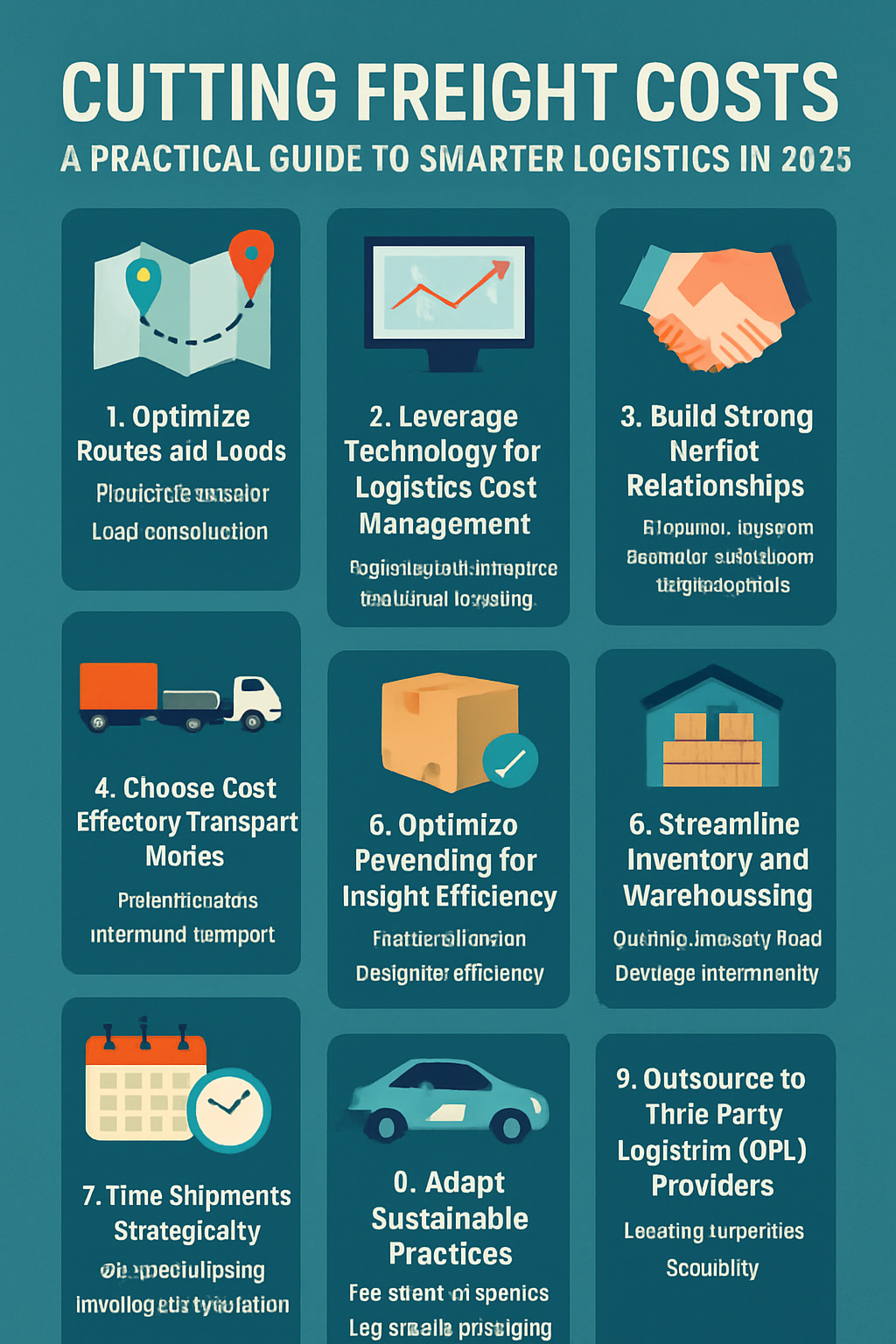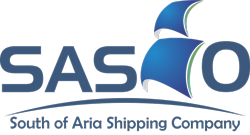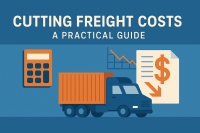Why Cutting Freight Costs Matters
Freight costs directly impact a company’s bottom line, often accounting for 10-20% of total operational expenses. Implementing effective cost-cutting strategies can minimize freight expenses, improve cash flow, and enable businesses to offer competitive pricing. ،thats why, mastering how to reduce logistics cost of transportation is critical for long-term success. Additionally, logistics cost management ensures timely deliveries, boosting customer satisfaction and loyalty.
9 Proven Strategies to Cut Transportation Costs
Below are ten comprehensive cost-cutting strategies designed to reduce transportation logistics costs while maintaining service quality. Each strategy is supported by practical examples and considerations for implementation in 2025.
1. Optimize Routes and Loads
Route and load optimization is a cornerstone of cutting freight costs. By leveraging technology, businesses can minimize fuel consumption and reduce transit times.
- Route Optimization: Use advanced route planning software like NextBillion.ai Free Route Planner to identify the most efficient paths, factoring in real-time traffic, weather, and road conditions. This approach reduces fuel costs and ensures faster deliveries, directly contributing to freight cost reduction.
- Load Consolidation: Maximize vehicle capacity by combining smaller shipments into full truckloads. This reduces the number of trips and lowers per-unit shipping costs.
- Minimize Less-Than-Truckload (LTL) Shipments: LTL shipments are often costlier per unit. Collaborate with nearby businesses or use freight pooling to fill trucks, further cutting freight costs.
Cutting Freight Costs Example: A regional distributor consolidated deliveries to multiple stores into a single truckload, reducing fuel costs by 18% and improving delivery efficiency.
2. Leverage Technology for Logistics Cost Management
Technology is transforming logistics cost management, offering data-driven solutions to minimize freight expenses.
- Freight Spend Analytics: Use AI-driven analytics to track shipping expenses, identify inefficiencies, and forecast costs. These tools help businesses make informed decisions to cut transportation costs.
- Real-Time Tracking: Digital platforms provide visibility into shipments, enabling proactive adjustments to avoid delays or costly disruptions.
- Automation: Automated container loading and unloading systems reduce labor costs and prevent product damage, enhancing overall efficiency.
Tool Tip: A cutting freight costs calculator can estimate savings from route optimization or mode selection. Many logistics platforms, like Freightos, offer free calculators to analyze potential savings.
3. Build Strong Carrier Relationships
Strong carrier partnerships are key to freight cost reduction. Long-term relationships can secure better rates and improve service reliability.
- Negotiate Long-Term Contracts: Commit to consistent shipping volumes to lock in competitive pricing, protecting against market fluctuations. This ensures predictable costs and priority service during peak periods.
- Data-Driven Negotiations: Use historical shipping data and industry benchmarks to negotiate favorable terms, helping to minimize freight expenses.
- Avoid Serial Rate Shopping: Building trust with a select group of carriers ensures consistent service and better rates compared to constantly chasing spot market deals.
Cutting Freight Costs Example: A manufacturing company can secure a 12% rate reduction by signing a two-year contract with a trusted carrier, stabilizing costs during a volatile market.
4. Choose Cost-Effective Transport Modes
Selecting the right transportation mode is critical for cutting freight costs. Each mode—truck, rail, ship, or air—offers unique cost and speed trade-offs.
- Evaluate Modes: For non-urgent shipments, opt for rail or ocean freight over air to significantly reduce transportation logistics costs. For example, ocean freight can be 50-70% cheaper than air for bulk goods.
- Intermodal Transport: Combine modes, such as rail and truck, to balance cost and delivery timelines. This approach is particularly effective for long-haul shipments.
- Recalibrate Speed: Avoid overusing expensive modes like air freight when slower options meet customer needs.
Cutting Freight Costs Example: GE Gas Power implemented a data-driven model to balance air, ocean, and ground transportation, using intermodal consolidation to meet delivery needs while significantly reducing freight costs..(arxiv)
5. Optimize Packaging for Freight Efficiency
Efficient packaging reduces weight and space, directly contributing to freight cost reduction.
- Reduce Dunnage: Minimize excess packaging materials like air bags or strapping to lower dimensional weight pricing costs.
- Design for Efficiency: Involve logistics teams in product design to create compact, stackable packaging. This maximizes pallet space and reduces the number of shipments.
- Test Durability: Ensure packaging protects goods without adding unnecessary weight, balancing cost and product safety.
Cutting Freight Costs Example: Dell, in collaboration with Walmart and Fresh Pak Corp., replaced heavy wooden pallets with Eco‑Sheet slip sheets—saving over $30 million in packaging costs and fitting 25% more freight per container. This sustainable packaging redesign also reduced freight weight by 17,000 tons in a year (palletenterprise).
6. Streamline Inventory and Warehousing
Strategic inventory and warehousing practices can reduce transportation logistics costs by minimizing shipment frequency and distances.
- Optimize Inventory Levels: Maintain just-in-time inventory to reduce the need for frequent shipments, improving cash flow and logistics cost management.
- Strategic Warehousing: Store products in regional warehouses closer to customers to shorten transport distances, lowering costs.
- Warehouse Efficiency: Ensure warehouses are organized and safe to avoid delays or fines that could increase freight expenses.
Cutting Freight Costs Example: Coca‑Cola implemented just‑in‑time inventory systems and cross‑docking in its global warehouses. This strategic combination lowered inventory holding costs by 30% and improved on‑time deliveries by 25% (eoxs).
7. Time Shipments Strategically
Timing shipments strategically can unlock lower rates and improve carrier efficiency, a key aspect of cutting freight costs.
- Off-Peak Shipping: Schedule shipments on quieter days, such as Mondays or Fridays, to access lower rates and better carrier availability.
- Flexible Pick-Up Windows: Offer later pick-up times (e.g., 6-12 p.m.) to allow carriers to backhaul, reducing empty miles and potentially lowering rates.
- Quick Loading: Streamline loading processes to within one hour to improve carrier efficiency and negotiate better pricing.
Cutting Freight Costs Example: The PierPASS program at the Ports of Long Beach and Los Angeles successfully shifted about 30–35% of daily cargo movements to off‑peak windows—enabling carriers to cut operational costs by up to 30% compared to peak-hour deliveries (researchgate)
8. Adopt Sustainable Practices
Green logistics not only supports sustainability goals but also helps minimize freight expenses.
- Fuel-Efficient Vehicles: Partner with carriers using hybrid or electric vehicles to reduce fuel surcharges and operational costs.
- Eco-Friendly Packaging: Use lightweight, recyclable materials to lower shipping weight and cut transportation costs.
- Long-Term Savings: Sustainable practices can qualify for incentives and reduce costs over time, aligning with corporate responsibility.
Cutting Freight Costs Example: Hindustan Zinc partnered with GreenLine Mobility Solutions on an electrified logistics overhaul—deploying electric trucks, LNG alternatives, and a battery‑swapping network in a ₹400 crore project to reduce fuel costs and carbon emissions simultaneously (reuters)
Resource: The article "Principles of Sustainable Logistics" available on ResearchGate, provides comprehensive strategies for sustainable logistics, covering economic, social, and environmental dimensions.
9. Outsource to Third-Party Logistics (3PL) Providers
Outsourcing to 3PL providers is a powerful way to cut transportation costs, especially for smaller businesses.
- Leverage Expertise: 3PLs, like SASCO, use their carrier networks to secure better rates, helping minimize freight expenses.
- Reduce Internal Costs: Outsourcing eliminates in-house logistics teams, saving on salaries and infrastructure for better logistics cost management.
- Scalability: 3PLs offer flexible solutions to adapt to changing needs, ensuring consistent freight cost reduction.
Cutting Freight Costs Example: Caterpillar reduced its logistics costs by around 15% by outsourcing to DHL Supply Chain. Leveraging DHL’s expertise and network allowed Caterpillar to scale operations efficiently and improve service quality (broadrangelogistics)

How to Implement Freight Cost Reduction Strategies in the Middle East
To start cutting freight costs in the Middle East, follow these steps tailored to the region’s unique logistics landscape:
- Analyze Current Expenses: Use a cutting freight costs calculator to identify inefficiencies in your shipping operations. Online tools provide detailed cost breakdowns for regional routes.
- Invest in Technology: Adopt logistics software for real-time tracking and route optimization to reduce transportation logistics costs, especially for complex Middle Eastern trade routes.
- Negotiate with Carriers: Partner with local providers like SASCO, one of the Best Freight Forwarder in Iran, to secure better rates and minimize freight expenses. SACO’s regional expertise enables shorter transit routes through Iran, overcoming challenges like Red Sea disruptions and regional trade complexities.
- Optimize Packaging and Inventory: Redesign packaging and streamline inventory to cut transportation costs in high-demand markets like the UAE or Saudi Arabia.
- Monitor Regional Trends: Stay informed about fuel prices, regional tariffs, and geopolitical events, such as Red Sea disruptions, to adapt cost-cutting strategies in 2025.
Ready to reduce transportation logistics costs in the Middle East? Visit SASCO for tailored freight forwarding solutions to start cutting freight costs today!
Resource: Download this cutting freight costs PDF from SASCO for detailed tips.
Conclusion
Cutting freight costs is a strategic necessity for businesses in 2025. By implementing cost-cutting strategies like route optimization, technology adoption, carrier negotiations, and sustainable practices, companies can reduce transportation logistics costs and boost profitability. Tools like a cutting freight costs calculator and resources like cutting freight costs PDFs provide practical support for implementation. Stay proactive in logistics cost management, monitor market trends, and adapt to challenges like tariff volatility or geopolitical disruptions to achieve lasting savings.







